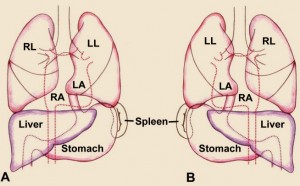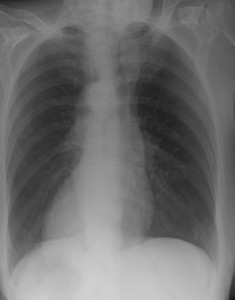Situs inversus is a physical condition due to which the organs within the chest as well as abdomen are arranged in an absolute mirroring manner; reversal of the conventional or natural position. Conventional development phenomena of human body lead to asymmetrical positioning of the internal organs in the stomach or chest. Generally, the heart is set on the left side of the human body where as other organs such as liver, spleen etc is conventionally on the left side of the body. Lung on the left side of the body has two lobes whereas the lung on the right has three lobes. This naturally normal arrangement of physical organ is known as ‘situs solitus’
Contrary to this in 1 out of 8500 individuals these organs, in the chest as well as the stomach are positioned in exact opposite manner. For example, the heart which is supposed to be on left may be positioned on the right hand side; this condition is called as dextrocardia or situs inversus totalis. The two lobed lungs is on the right so is liver spleen etc, where as the three lobed lung is detected on the left side of the body. Since this kind of arrangement of the body organ is inverse to ‘situ solitus’ the condition is scientifically referred to as ‘situs inversus’, however the functionality and relationship between these organs remains the same in most cases, but rarely functional problem may occur.
Causes of Situs Inversus
Initially in conventional growth of embryo, the structure resembling a tube that later transform into heart forms a loop on the left, indicating the left or right axis also deciding the positioning of other internal organ. Though the mechanism that leads the heart loop to shift to left is not completely understood, minimally even a single gene is been said to have an important role in the process.
Complications
There are several factors that may cause Situs inversus and it is extremely rare that the condition may be genetic and passed on through generation in the family. In most cases the condition is inadvertent and may happen to a person for the first time in the family. There are no medical complications or symptoms resulting due to situs inversus in most cases. It is recorded that approximately 3 percent to 5 percent of all situs inversus affected individuals also have some kind of functional heart issue. It is comparatively higher than the rate of heart issues recorded in normal individuals which is approximately 1 percent.
Diagnosis of Situs inversus
Situs inversus are usually detected inadvertently when a person with the condition undergoes medical checkup. It is often detected when a doctor using stethoscope checks the person’s heartbeat (This may be usually during early days of life) and learns that the heart is placed on the left. Further diagnosis confirms the prevalence of the condition. The confirmation is usually done through Magnetic Resonance Imaging (MRI), Computer Tomography scan or CT scan or other imaging techniques.
Treatment for Situs inversus
There is no treatment for turning the Inversus condition to Solitus. However, in cases wherein additional physical adversities are noticed, the symptoms and the condition are treated according to the disease or disorder. Also, there is no identified prevention technique for the condition. It should be known that this condition has good prognosis and life expectancy is usually normal if there are no other hazardous physical issue along with situs inversus.
Situs Inversus Pictures
Check out the pictures to find out how the throaic organs are placed in a reverse manner in few patients

